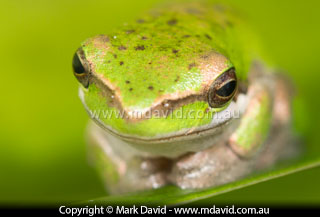
Most guides to macro photography, like my ones for example, recommend a small aperture (otherwise known as a big f-number like f/10 or f/16) to get as much depth of field as possible. But sometimes there’s an advantage in doing things differently.
Previous tip | Next tip

When you start focusing on things up close, the depth of field gets crazy small and the only way to counteract that — to get some depth of field back — is to keep making your aperture tinier. Which is what most macro photographers do.
But you don’t have to work that way. Opening up your lens to a big aperture (in the picture of the grasshopper above it was f/4.5) can give your pictures an especially tiny depth of depth of field in a way that can add lots of blurry interest to a shot.
And an advantage of using a big aperture is that, because it lets in lots of light, you can turn off the flash, even if you’re working your camera hand-held. So everything appears more natural.

A smaller-than-usual depth of field allowed a green frog to blur into its green surroundings.
With a tiny depth of field you have to be extremely careful where you focus though — I focused on the flat front of the grasshopper’s head and it took me a few goes to get it the way I wanted.








